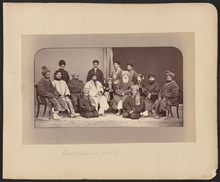| Dost Mohammad Khan دوست محمد خان | |||||
|---|---|---|---|---|---|
| Emir of Afghanistan Amir al-Mu'minin | |||||

Miniature on ivory in gold frame, by a Company artist.
| |||||
| Emir of Afghanistan | |||||
| Reign | 1826 – 2 August 1839 1845 – 9 June 1863 | ||||
| Predecessor | Shah Shujah Durrani | ||||
| Successor | Wazir Akbar Khan | ||||
| Born | 23 December 1793 Kandahar, Durrani Empire, now Afghanistan | ||||
| Died | 9 June 1863 (aged 69) Herat, Emirate of Afghanistan, now Afghanistan | ||||
| Spouse | 25 wives | ||||
| Issue | 27 sons and 25 daughters at the time of his death | ||||
| |||||
| Dynasty | Barakzai dynasty | ||||
| Father | Sardar Payinda Khan Muhammadzai (Sarfraz Khan) | ||||
| Mother | Zainab Begum | ||||
| Religion | Afghan Sunni Islam | ||||
The Musahiban family started with his older brother, Sultan Muhammad Khan, nicknamed "Telai", meaning "golden", a nickname he was given because of his love of fine
Background and rise to power
Dost Mohammad Khan was born to an influential family on 23 December 1793 in Kandahar, Durrani Empire.[6] His father, Payindah Khan, was chief of the Barakzai Tribe and a civil servant in the Durrani dynasty. Their family can be traced back to Abdal (the first and founder of the Abdali tribe), through Hajji Jamal Khan, Yousef, Yaru, Mohammad, Omar Khan, Khisar Khan, Ismail, Nek, Daru, Saifal, and Barak. Abdal had Four sons, Popal, Barak, Achak, and Alako.[7] Dost Mohmmad Khan's mother is believed to have been a Shia from the Azerbaijani Qizilbash group.[8][9][10]
His elder brother, the chief of the Barakzai, Fatteh Khan, took an important part in raising Mahmud Shah Durrani to the sovereignty of Afghanistan in 1800 and in restoring him to the throne in 1809. Dost Mohammad accompanied his elder brother and then Prime Minister of Kabul Wazir Fateh Khan to the Battle of Attock against the invading Sikhs. Mahmud Shah repaid Fatteh Khan's services by having him assassinated in 1818, thus incurring the enmity of his tribe. After a bloody conflict, Mahmud Shah was deprived of all his possessions but Herat, the rest of his dominions being divided among Fatteh Khan's brothers. Of these, Dost Mohammad received Ghazni, to which in 1826 he added Kabul, the richest of the Afghan provinces.[11]
From the commencement of his reign he found himself involved in disputes with Ranjit Singh, the Sikh ruler of the Punjab region, who used the dethroned Sadduzai prince, Shah Shujah Durrani, as his instrument. In 1834 Shah Shujah made a last attempt to recover his kingdom. He was defeated by Dost Mohammad Khan under the walls of Kandahar, but Ranjit Singh seized the opportunity to annex Peshawar. Dost Mohammad sent his son Akbar Khan to defeat the Sikhs at the Battle of Jamrud in 1837.[6] The non- recovery of the Jamrud Fort became the Afghan Amir's worst concern.[11]
European influence in Afghanistan[edit]
Main article: European influence in Afghanistan
At the intersection of British, Russian and, to a lesser degree, French imperial interests, political maneuvering was necessary. Rejecting overtures from Russia, he endeavoured to form an alliance with Great Britain, and welcomed Alexander Burnes to Kabul in 1837. Burnes, however, was unable to prevail on the governor-general, Lord Auckland, to respond to the emir's advances. Dost Mohammad was enjoined to abandon the attempt to recover Peshawar, and to place his foreign policy under British guidance. He replied by renewing his relations with Russia, and in 1838 Lord Auckland set the British troops in motion against him.[11] To enable such an action, the British manufactured the evidence needed to justify the overthrow of the Afghan ruler.[citation needed]
Captivity
In 1835, Dost Mohammad Khan, the youngest and the most energetic of the Barakzai brothers, who had supplanted the Durrani dynasty and become Emir (lord, chief or king) of Kabul in 1825, advanced up to Khaibar Pass threatening to recover Peshawar. In 1836 Hari Singh Nalva, the Sikh general who along with Prince Nau Nihal Singh was guarding that frontier, built a chain of forts, including one at Jamrud at the eastern end of the Khyber Pass to defend the pass. Dost Muhammad erected a fort at `Ali Masjid at the other end. In the beginning of 1837, as Prince Nau Nihal Singh returned to Lahore to get married and the Maharaja and his court got busy with preparations for the wedding.
Dost Muhammad Khan sent a 25,000 strong force, including a large number of local irregulars and equipped with 18 heavy guns, to invest Jam rud. The Sikh garrison there had only 600 men and a few light artillery pieces. The Afghans besieged the fort and cut off its water supply, while a detachment was sent to the neighbouring Sikh fort of Shabqadar to prevent any help from that direction. Mahan Singh Mirpuri, the garrison commander of Jamrud, kept the invaders at bay for four days and managed meanwhile to send a desperate appeal for help to Hari Singh Nalva at Peshawar. Nalva rose from his sick bed and rushed to Jamrud.
In the final battle fought on 30 April 1837, the Afghans were driven off, but Hari Singh Nalva was mortally wounded. In 1838, the Sikh monarch became a party to the Tripartite Treaty, as a result of which Shah Shuja` was reinstalled on the throne of Kabul in August 1839 with British help. Dost Muhammad Khan was exiled to Mussoorie in November 1839, but was restored to his former position after the murder of Shah Shuja` in April 1842. He thereafter maintained cordial relations with the Lahore Darbar. The second Anglo Sikh war reawakened Dost Muhammad`s ambition to seize Peshawar and the trans Indus territories, although overtly he sympathized with the Sikhs and even hired out an irregular Afghan contingent of 1500 horse to Chatar Singh, leader of Sikh resistance against the British.





0 Comments